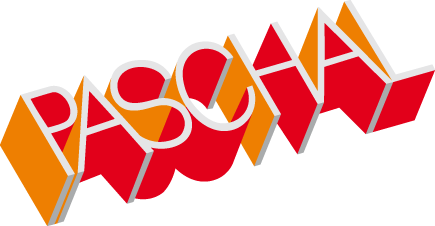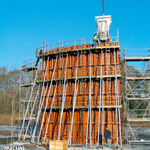Multi-functional working platform Multip
The highest safety class according to DIN EN 12811-1
Perfectly scaffolded, even upon setupWorking scaffolds serve to offer a suitable and safe work site for the work to be done - and allow safe access to it.
Yet what initially sounds self-explanatory - something for anyone working on such scaffoldings to impose as a requirement - indeed has its perils. After all, the surroundings on such a safe work site have to be set up first of all – and does this requirement apply at all to the assembly work involved? Then, there are humans themselves - a vulnerable and defective system with a tendency to overlook things - or even take a lax approach to implementing requirements - as well as underestimating certain dangerous areas due to the habitual nature of work in such areas. In the press, too reports of accidents resulting from material fatigue on scaffoldings are spread by the press.
All of that also and particularly applies to working scaffolds on formwork.
Tradition vs. Efficiency
Unlike climbing installations, working scaffolds on formwork in Germany are, in many cases, stuck at the technical level of the 1960s: L-shaped brackets made of steel are attached to the formwork - and then conventionally covered with planks by site, plus side guards made of wooden boards. At least this is how it should look in the finished condition. The assembly is performed on the vertically-positioned formwork - partially at rather high altitudes of quite a few metres, whereby the workers are standing on more or less wobbly ladders or performing acrobatic feats of sorts on the formwork. Until the brackets are then ideally covered, the conditions in between may become rather adventurous – despite the Operational Safety Directive. Based on the particular construction site conditions, materials, state of wear/soiling/age and suitability may fluctuate greatly (due to different board lengths and thicknesses, for example). It is not always the case that all edge boards are complete and overlapping.
After some (avoidable) fatal accidents on construction sites, the understanding of work safety has changed greatly - at first, in France. The notion of laisser-faire typically associated with the French mentality was over at the start of the 2000s - now, the highest safety level prevailed. Working scaffolds may no longer have surface defects; firmly assembled and slip-proof coverings were required, along with many other safeguards. Whoever was seeking scaffoldings in France needed - effective immediately - first-rate European technology. German suppliers have also faced this challenge and sought efficient structural-design solutions – some of them even surpassed those of their French colleagues.
The Multip
The multifunctional working-platform Multip by PASCHAL has proven to be one of the most efficient and most highly-safeguarded systems for work platforms on formwork. This is due to the following:
- The assembly does not take place on the vertically-positioned formwork, but instead before the set-up of the formwork – quickly and conveniently, on the ground. This helps to avoid dangerous situations even at the assembly stage. Setting or removal of connectors, the assembly or removal of crane lifting eyes or the removal of tie rods can be performed quickly and safely.
- The assembly itself is simple: after the folded Multip has been attached to the formwork, it is simply opened. Further components of this complete system are integrated ladders which enable safe access to the individual work sites at various heights. This means that platforms, ladders and scaffolding are transported as a unit and must not also be assembled individually. In this case, time savings are significant.
- Immediately after its unfolding, the Multip guarantees the highest-possible level of safety on a construction site. There are no assembly-related delays, no improvisation necessary.
- From safe work sites, all accessory parts (such as connectors and tie points) can be operated more quickly.
- If the use of the Multip is simultaneously planned for several construction sites, it can even remain as a whole on the formwork: it is then simply folded, stacked on top of the formwork and carried to the next construction site. This means that assembly processes are avoided almost altogether. – Plus, when the Multip is rented along with other equipment by a seller/distributor, it can be ordered already pre-assembled to the formwork.
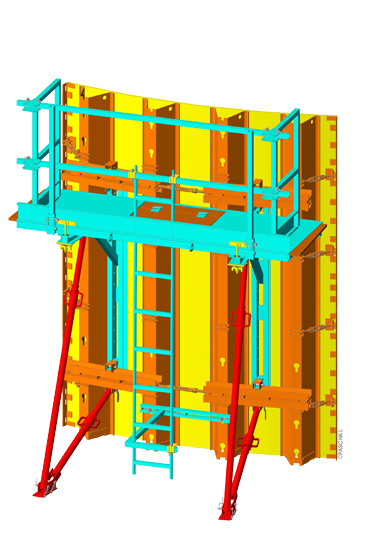
Multip, the multifunctional working platform, is suitable for use on various formwork systems – here, in the equipment variant for the TTR, Circular Trapezoidal Girder Formwork with adjustable radius. Ladders, platforms and handrails are firmly installed. They can be folded with a mechanism designed especially for transport.
Generate growth through efficiency
It is a known and enduring problem: profit is always followed by investment. This also applies to advanced working scaffolds.
In comparison to traditional working scaffolds with their proven technology which has outlasted more than 50 years, the equipment on modern working scaffolds is noticeably more comprehensive and therefore heavier – approx. three times heavier – and the weight is proportional to their higher costs (regardless of the advanced technology involved in the entire process).
In comparison to the automobile industry - for instance, with vans from the same era (e.g. VW T1 “Bully” vs. T5), their evolution seems just as dramatic; the weight of vans has likewise more than doubled, and the developments in pricing seem shocking. Even so, nowadays no one would want to trade a modern van for a classic VW van. After all, modern technology has enormous and immediately-effective benefits in terms of comfort and convenience, safety and performance (e.g. speed and capacity), which justify the initial steep cost – and after some time, these benefits have amortised themselves to even become increased revenue - that is to say, a cash-value result. This is when working with modern equipment becomes profitable for its owners.
The situation for working scaffolds is no different. Projections which are also comprehensible with other systems - with very moderate deployment numbers based on the Handbook of Construction Organisation reach the conclusion that modern working scaffolds start to pay for themselves after merely four years of use - that is to say, users have worked without losses in comparison to the expense associated with the leading brackets. In that case, since their wooden boards have a shorter useful life, the amortisation interval is in principle even shorter; and even for high deployment numbers, this time approaches more quickly.
Horror scenario vs. immediate safety
Each single accident on working platforms is one too many. Apart from an avoidable accident on the part of the affected person - even if it may be just an injured finger which leads to a three-day work stoppage for one person - accidents have myriad known consequences at an organisational and economic level. Here, prevention can be a decisive factor in success!
That's why in Germany, too, construction companies are increasingly relying on Multip or other firmly-mounted working scaffolds on formwork - some parallel to the pre-existing brackets. Yet it will take a good while until area-wide coverage is in place (as is already available in France) in Germany and the neighbouring countries.
In this regard, the existing DIN EN 12811-1 represents merely the least common technical denominator. For the future, increasingly stringent safety regulations are expected for Germany in terms of working scaffolds. Systems such as the Multip are still well ahead of the prevailing technical standards - and with that, best-equipped to meet increasing standards and the highest of requirements.
Technical Data: Multip
- Load capacity: live load 2.0 kN/m², calculation according to DIN 4420 T1 and DIN 18800 T1-T3
- Working space: between formwork and guard rail: 72 cm
- Platform sizes: 238 cm with access hatch (depending on the formwork system); 133 cm without an access hatch (for LOGO.3 midi-elements); extensions: 15 cm, 30 cm, 45 cm (for the use of fitting elements and use in a horizontal position).
- Individual components: platform, mounting bracket, diagonals and guard rail (pre-assembled onto the formwork on request)
- Accessories: support structure made of prop, support below and a foot plate; suspending piece for props, ladder (260 cm or 130 cm in length); ladder fastening for prop and guard rail; folding door on the side as a lateral safeguard and as a guard rail extension when extensions are used.
The Multip fits on the LOGO.3 system formwork as well as the Circular Trapezoidal Girder Formwork with adjustable radius TTR and TTS, for which an equipment variant is available.
Tools
- Operational Safety Directive on OHS Regulations in the Provision of work resources (BetrSichV). German Federal Ministry of Justice: last amended on 26.11.2010 (www.juris.de)
- DIN EN 12811-1 – Temporary structures for edifices – Part 1: Working scaffolds. Deutsches Institut für Normung (Beuth-Verlag, Berlin).
- GSV Guidelines – Instruction for the properly compliant and safe use of formworks and support scaffoldings Quality Assurance Association for Concrete Formwork (http://www.gsv-betonschalungen.de/media/files/Download_Leitfaden/2010-12-GSV-Leitfaden-Sicherheit-Schalung-Traggerueste.pdf)
- Handbook for Work Organisation in Construction – Formwork construction, frame formwork, walls (Zeittechnik-Verlag, Neu-Isenburg).
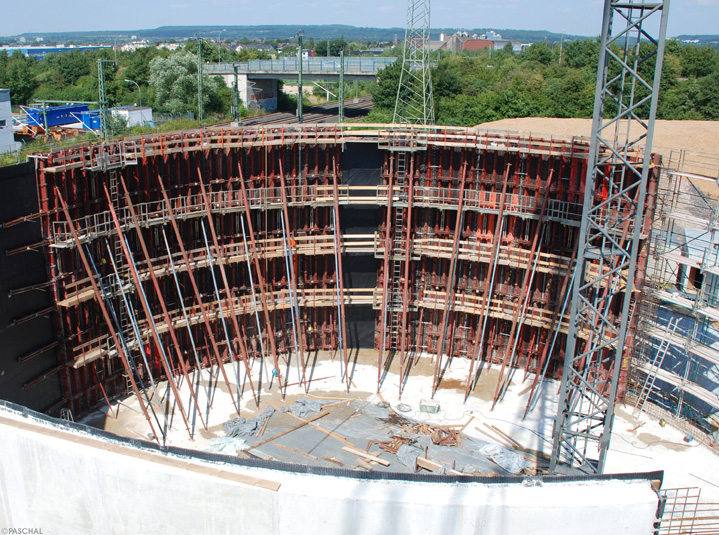 In Germany, too, the Multip is in use more and more frequently – as one can see here, with the TTR and the conventional brackets, in the construction of a biogas installation; the Multip operates the third alley from below. Their benefits are proven during the completion of the circular formwork (approx. 12 m high).
In Germany, too, the Multip is in use more and more frequently – as one can see here, with the TTR and the conventional brackets, in the construction of a biogas installation; the Multip operates the third alley from below. Their benefits are proven during the completion of the circular formwork (approx. 12 m high).
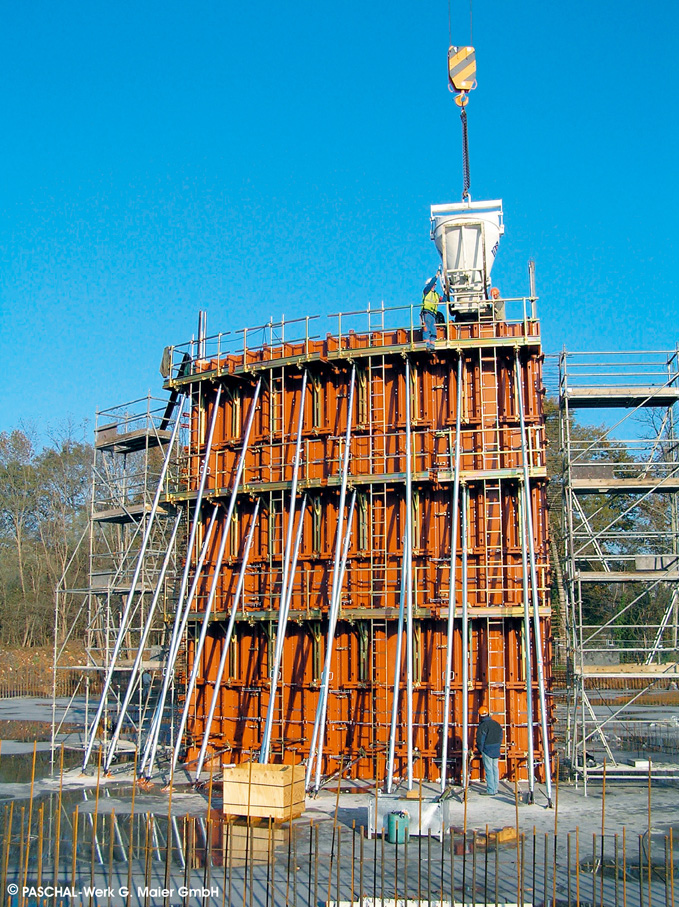
In France, as one can see here during the construction of a sewage water treatment plant with the TTS, the Multip is used daily on the most various of construction sites.
